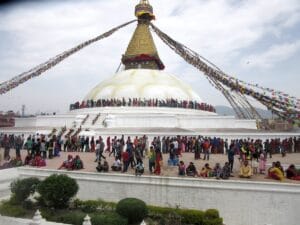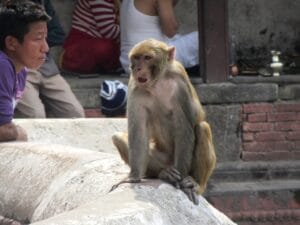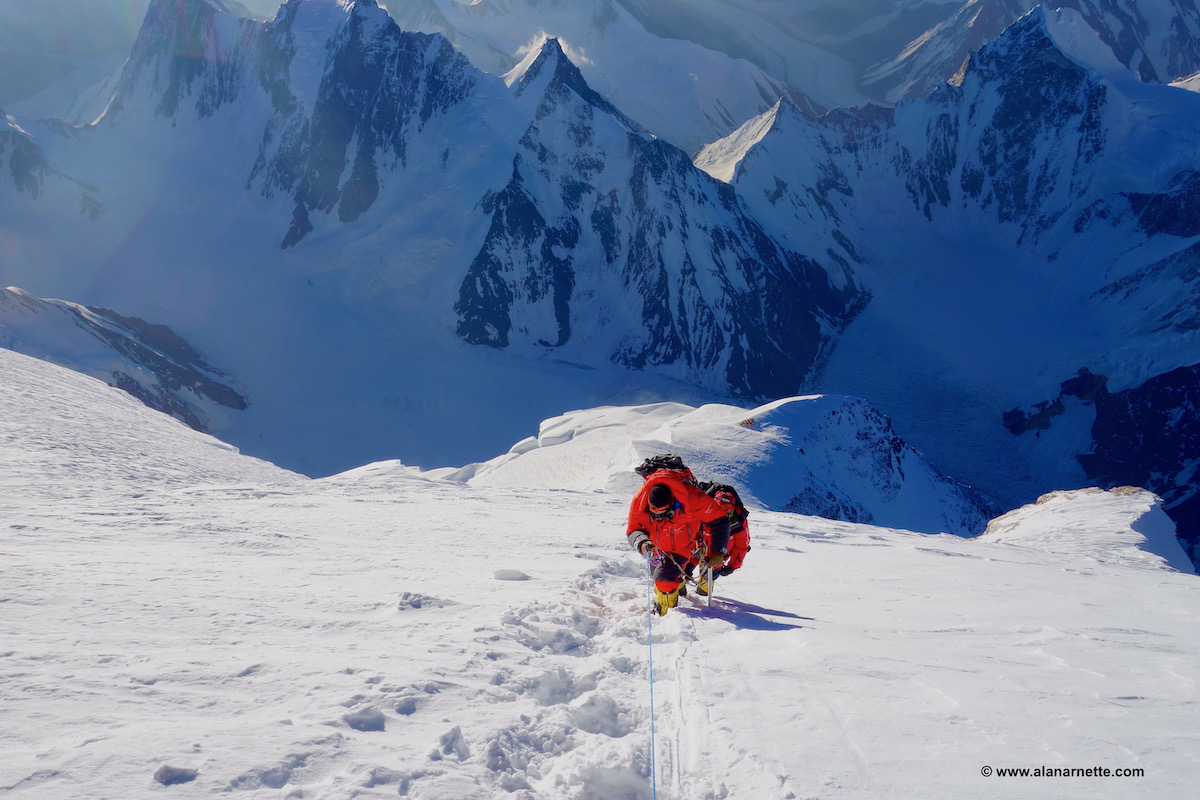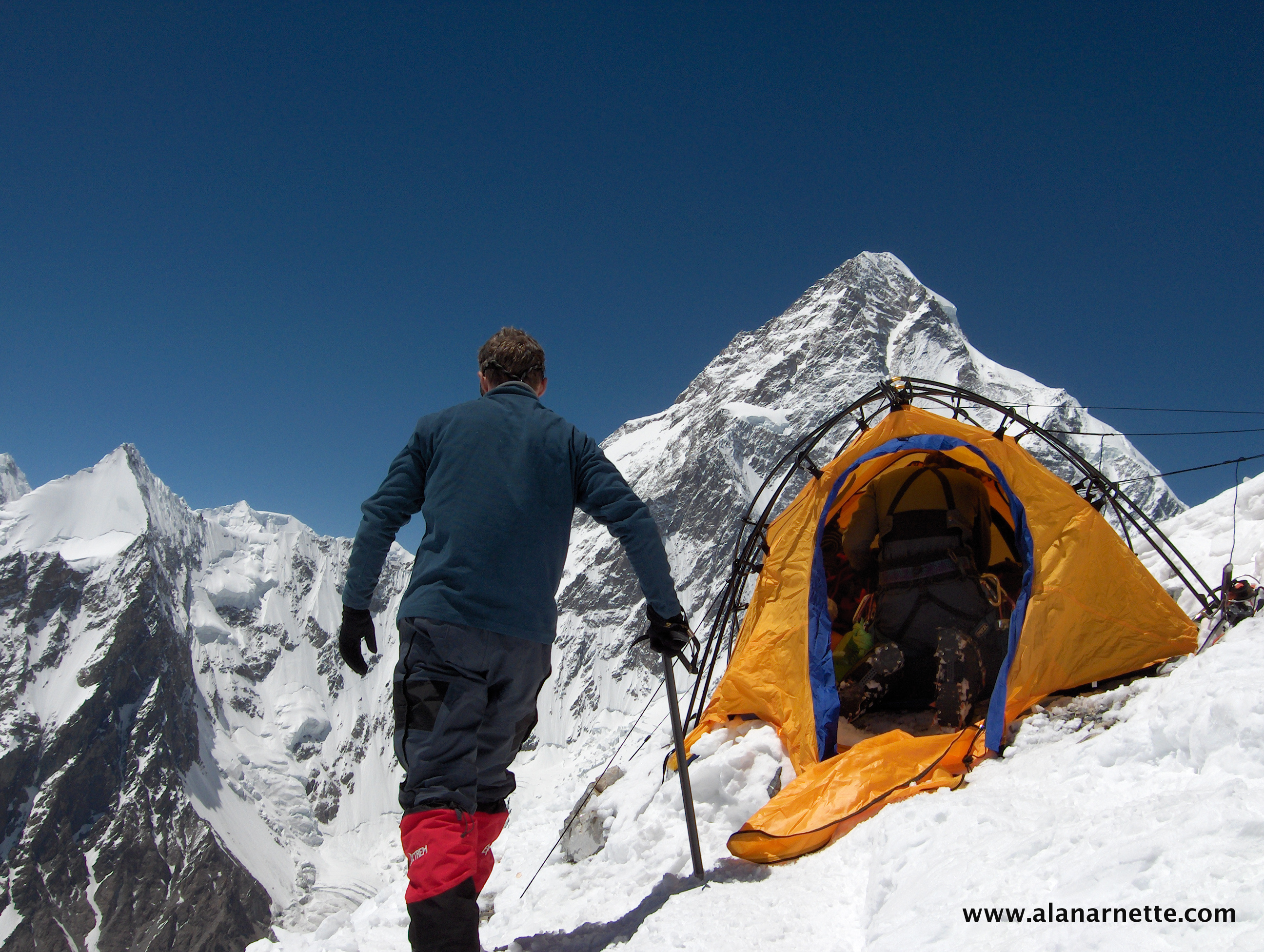With all the Mount Everest Guide climbers in Kathmandu for their spring 2020 Everest attempt, the process of getting to know one another begins. But first a tour of Kathmandu.
Virtual Everest 2020 – Support the Climbing Sherpas is a joint project of Alan Arnette and several global guide companies. Our objective is to entertain Everest fans during the Coronavirus spring closure and raise money to help the Climbing Sherpas who are not working this spring. While there will be accurate historical references, this series is a work of fiction. Names, characters, and incidents either are products of my imagination or are used fictitiously. Any resemblance to actual events or locales or persons, living or dead, is entirely coincidental. Please join us by making a donation using the links below plus by adding your Everest experiences in the comment section.
Exploring Kathmandu
She left her family on April 3, and now, April 7, She is beginning to get into the flow. Four members of the Mount Everest Guide team met for lunch before heading out to get sim cards for their phones and buy a few last-minute items. With the others arriving later that night, they had a simple dinner and went to bed early, trying to shake off the jetlag.
He looked at the Caller ID on his iPhone, 9779808080345. A thirteen digit number must mean only one thing; She was calling from Nepal. “Hello?” he said with anticipation. “Hi, honey, it’s me.” She said with gratitude that the connection was working. “So good to hear your voice. We miss you. I miss you so much.” He said with a deep sense of reflection. “How are you? How’s Kathmandu? Have you seen a yak?” He asked, teasing her like he always does.
With her iPhone now using an NCELL card, She could call home. It only cost about a US 2 cents per minute, so She talked to her husband and kids for over an hour and only cost $12. She hoped She could get service on the way to base camp but also planned to use the WiFi offered by EverestLink.
“Can you put the kids on? She asked, missing them terribly. “Mom!” they said in unison. “What’s it like? Do they speak English? What’s the food like? Tell us, tell us everything.” The 12 and 14-year-old were overjoyed hearing their mother’s voice. “Mom, guess what? I did a speech today at school about you climbing Mt. Everest. Everyone was so impressed. But some said it was dangerous and people die. I told them what you told us about being careful, training hard and being with the best guides. I told them I wasn’t afraid; that I was proud of you.” As the 12-year-old spoke without breathing, tears well up in her eyes. “Thank you, honey. I’m proud of you also.” They hung up promising to talk again before She left Kathmandu, maybe a video chat next time.
With her first-day checklist complete, She crawled into bed and went immediately to sleep.
The alarm on her altitude watch went off at seven the next morning. She felt like She had just gone to sleep but was rested. After a quick shower, She ignored her hair, letting it air dry in the warm air of Kathmandu. Dressed in jeans and a Patagonia T-Shirt, She joined the group for breakfast.
The hotel had a nice buffet with scrambled eggs, bacon of sorts, toast, and jam plus coffee and tea. It was simple but good. She loaded her plate but no too much. She didn’t see Dutch or the couple inside, so She went outside to the covered patio. There She found the group along with the new members. All, but one person, were engaged in “getting to know you” conversations. Of course, Dawa was right in the middle, flashing his Everest smile and laughing easily. There was a relaxed feeling to the group; the talk flowed smoothly, as did the laughs. She immediately had a good feeling but noted the loner.
A large bus pulled up outside the hotel to take them on a tour of Kathmandu. A tour was often a standard part of an Everest climb and helped introduce the climbers to Nepal. Her group of seven climbers plus three trekkers along with the ever-present Dawa and a tour guide hopped on the bus. There were more than enough seats for everyone to spread out. The coach lumbered off to visit the usual sites: Boudhanath Stupa, Pashupatinath Temple, and Swayambhunath
Warning: this post and video has graphic descriptions and images that may be disturbing to some people
Their first stop was to the Pashupatinath Temple, where both Hindus and Buddhists take their dead for cremation ceremonies. Everything was out in public, and the families were accustomed to having tourists and locals watch the ceremonies complete with camera in hand.
She learned that if it is the death of a mother, the youngest son leads the ceremony, if the father, then the oldest son takes charge. The total cost was between $40 to $60, a lot of money for many of these families. It is believed that those who die in Pashupatinath Temple are reborn as a human, regardless of any misconduct that could worsen their karma.
The dead are usually cremated within 24 hours of death. The body is lovingly cleaned, sometimes painted before being wrapped in white cloth, and gently laid on a pyre of wood. The son then takes a flaming torch, circles the body many times before setting the structure aflame. The ceremony takes about three hours to complete, and the ashes are spread into the Bagmati River, which eventually joins the Ganges in India.
 She found the Sadhus, wandering ascetic yogis, fascinating. For a small donation, they pose for pictures in the temple area. The tour guide said they are trying to acquire liberation from the cycle of death and rebirth through meditation. She asked Dutch to take a picture of her with one of them. “My honor.” he stately replied.
She found the Sadhus, wandering ascetic yogis, fascinating. For a small donation, they pose for pictures in the temple area. The tour guide said they are trying to acquire liberation from the cycle of death and rebirth through meditation. She asked Dutch to take a picture of her with one of them. “My honor.” he stately replied.
Their next stop was to one of the largest stupas in South Asia, Boudhanath. It has become the focal point of Tibetan Buddhism in Nepal. With April 14, 2020, the start of the Nepal new year, around the corner, the Boudhanath was full of families praying for their dead of the past year. They circled all three levels of the stupa. Prayer wheels encased in the lower wall made for more crowds as many people, locals and tourists alike circled the base spinning each wheel.
She looked at the stupa with admiration. It had been damaged in the 2015 earthquake but you would never know that now. She looked at the eyes of Buddha and remembered the saying “Buddha is always watching.” Somehow She found that comforting.
The air was full of smoke and incense, and the sound of praying monks, clanging bells and announcements over a loudspeaker competed for the sensory overload. She observed the abject poverty and many disabled people begging for money.
She took a video for her family back home:
Their last stop was the Swayambhunath or Monkey Temple. Dutch was especially interested in trying to get a good photo of one of the 500 wild monkeys crawling around on the steps and buildings. She noted the Loner ignoring the monkeys but keen on getting a workout in by climbing the 365 well worn-steps leading to the top of the temple as fast as he could.
On the bus drive back, She sat across the aisle from the Loner. “Pretty good workout at the temple, huh?” She said in a friendly tone. “Yes,” he replied, looking out the window, sweat beading on his forehead. Dutch and the couple were laughing loudly as they reviewed his monkey pictures. The other members of the team and trek were quietly talking amongst themselves except for the older gentleman who was fast asleep.
She settled back in her bus seat, taking inventory of the team, now ten strong. Their sole Western Guide had not joined them yet. He was busy getting their climbing permits and sorting out other details. He would meet them at dinner later that night.
She reflected on what She had seen today, different than anything She had been exposed to back home – cremations, chanting, prayer wheels, and flags—the intensity and devotion of the people. The respect and love while saying goodbye to a loved one. She was already letting the experience seep into her essence, open to learning, open to change. Back home, it was all about work and family. She had started to schedule in time for her, and this climb was a milestone in that journey. She was eager to see what would come next.
They returned to the hotel to do their final packing, planning to leave for Luka early tomorrow morning, weather permitting.
Tonight, the team would have their first dinner together. She was a bit anxious seeing the different personalities during the day. She began the process of sorting the group. Above all, She wanted a positive experience.
Climbing Sherpa Support
Who, how much, and how often you donate is a personal decision. Maybe you climbed with one of the guides, or plan to one day. Perhaps you have followed them for years and want to support their Climbing Sherpa team, or maybe you support by geography – Nepali, American, Austrian, British, New Zealand. It’s up to you and will be much appreciated.
My sincere appreciation to those companies who accepted my invitation to join Virtual Everest 2020 – Support the Climbing Sherpas:
- Alpine Ascents International: Click to Donate to Alpine Ascents’ Climbing Sherpas
- Adventure Consultants: Click to Donate to Adventure Consultant’s Climbing Sherpas
- Alpenglow Expeditions: Click to Donate to Alpenglow Expedition’s Climbing Sherpas
-
Climbing the Seven Summits: Click to Donate to CTTS’s Climbing Sherpas
- Furtenbach Adventures: Click to Donate to Furtenbach Adventure’s Climbing Sherpas
- International Mountain Guides: Click to Donate to IMG’s Climbing Sherpas
- Jagged Globe: Click to Donate to Jagged Globe’s Climbing Sherpas
- Madison Mountaineering: Click to Donate to Madison Mountaineering’s Climbing Sherpas
- Mountain Professionals: Click to Donate to Mountain Professional’s Climbing Sherpas
For an overview of the Virtual Everest 2020 – Support the Climbing Sherpas, please visit this post.
Climb On!
Alan
Memories are Everything






3 thoughts on “Virtual Everest 2020: Exploring Kathmandu”
Thank-you Alan for creating this narrative on an “off” year. Really appreciate living vicariously through our protagonist. Just out of curiosity, in your experience, how many or what percentage of climbers go through the effort of learning some basic Nepali before or during their climbs?
My husband and I have been learning Nepali for about 2 years, and last year did some trekking in Nepal, and we found it greatly enriched our experience. Although the guides speak English well, we were able to show personal interest and thus became friends more so than just a business transaction. Out of the various treking groups we came upon, we definitely had a closer relationship to our guide than any other. We felt like locals more so than tourists.
Thanks, Irina, glad you are enjoying the journey! In my experience, it’s a tiny % that try to learn almost any local language during travels. Maybe a few words and phrases having to do with beer and bathrooms, hello and goodby an thank you, but not much more. I do know a few friends who became more conversational like you nad your husband, but not many. I would be interested in hearing from other readers on this.
Thanks Alan! That’s too bad, in my opinion. Because if you’re spending a year or more in physical training to accomplish this feat, the least someone could do is spend a little bit of time to learn the culture, especially since climbers can spend close to 2 months with the locals, in the country, and on the mountain. Would certainly be cool to hear from other readers!
Comments are closed.